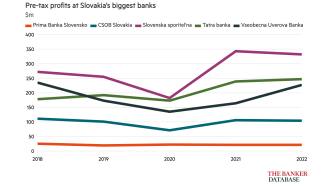Central and eastern Europe (CEE) is in vogue. Its economies are growing faster than western Europe, it is politically stable and its currencies are appreciating against the euro and the dollar.
Conditions are benign and the outlook is good: the environment seems entirely conducive to private equity investment.
Last year, for example, the private equity portfolio of the European Bank for Reconstruction and Development (EBRD) delivered returns of 55%, following net returns of 39% in 2004. The EBRD is the largest investor in private equity funds in central and eastern Europe and its experience has been mirrored by many smaller players in the industry.
“The fundamentals are very good for private equity here. The process of joining the EU has been a tremendous boost and the region is going through a period of dynamic change. That means new companies, new markets and new sectors,” says Henry Potter, senior banker at the EBRD.
“There are very few places in the world that offer democracy, GDP growth of 4%-6%, appreciating currencies and a stable political environment. You can get some of these elsewhere but not all of them. CEE is very much like Greece, Portugal, Spain and Ireland 15 years ago,” says Thierry Baudon, managing partner at Mid Europa Partners.
Bad old days
Of course, conditions were not always this favourable. Before 1992, private equity did not exist as an asset class in CEE and in the early days, the industry was primarily involved in expansion capital and privatisations.
Banks were prepared to lend only against secured assets and leverage did not exist. That meant those private equity firms that were in the region could only back businesses with equity – and this naturally dictated the types of companies they could go after.
“We used to hunt in packs. We would syndicate deals and we could only go for businesses with very fast growth prospects,” says Mr Baudon.
Despite, or perhaps because of this, private equity is credited with supporting, encouraging and developing a mid-market corporate sector in CEE.
“Private equity has been absolutely critical. Access to the capital markets was not easy and in many countries it still isn’t. No one else would spearhead the evolution of new industries in the region, such as mobile telephone 10 years ago. No one else would buy spin-offs from large, formerly state-owned conglomerates,” says Tod Kersten a partner at Enterprise Investors.
International trailblazers
Indeed, most private equity firms operating in the region during the 1990s were local. Only a few daring international players took the plunge early on – among them Mid Europa Partners, Enterprise Investors, Advent International and Warburg Pincus.
Even now, there is precious little involvement from large European and US firms – a reflection of the region’s particular characteristics.
By most definitions, CEE comprises 11 countries, the eight that acceded to the EU in 2004 (Czech Republic, Estonia, Hungary, Latvia, Lithuania, Poland, Slovakia and Slovenia) and the three that are scheduled to join (Bulgaria, Croatia and Romania). Poland has 40 million inhabitants but many of the others are extremely small – Slovenia has a population of just 1.5 million, for instance.
In total, there are 110 million people living in CEE and their combined GDP is half that of Germany (population 82 million), at some €600bn. There are many languages, customs and laws. It is deeply fragmented and likely to become more so as each country asserts its post-Communist individuality.
“CEE is largely made up of small countries so you can’t expect lots of big private equity deals. Most investments are in the order of €5m-€10m. Of course there are a number at €100m or so but most of the major global players would not get out of bed for deals of that size these days,” says Joanna James, managing director of Advent International’s central European operations.
The terrain is made more challenging because the market is almost entirely ‘unintermediated’. Whereas private equity firms operating in the US and western Europe invariably find themselves bidding for businesses via auctions organised by investment banking houses, deals in CEE tend to be structured by the vendor and the acquirer – banks are used primarily as lenders, rather than advisers or arrangers.
This means on-the-ground relationships are of paramount importance.
|
| “We’ve been here since the 1990s and we have built up some valuable contacts,” says Joe Schull, managing director at Warburg Pincus. “The market here is still in its infancy and for large buyout firms, it can be somewhat frustrating. The deals are smaller and the deal flow is slower than in the west,” he adds. |
Nonetheless, there are plenty of opportunities for those prepared to invest time and money in the region. The very nature of the market means that entry prices tend to be better value than in western Europe, so exit returns are likely to be higher. Mid Europa Partners has completed seven exits over the past eight years, for instance, generating an internal rate of return of about 40%.
In a yield-hungry environment, such figures have prompted intense interest from private equity investors and have made bankers increasingly prepared to lend the industry money. Three years ago, there was virtually no lending against cash flow. Now leverage of three to four times earnings before interest, taxes, depreciation and amortisation (Ebitda) is commonplace and most transactions are neither venture capital nor privatisations – they are buyouts.
“Leveraged finance pretty much did not exist here until 2003. Now it has come into fashion. EU accession was instrumental in this trend. Foreign direct investment has surged and banks have become a lot more comfortable with the risk profile of the region. Also, they are looking for better margins,” says EBRD’s Mr Potter.
Advent’s Ms James has a further explanation: “When the Berlin Wall came down, each country had more or less one bank. Then the banks were split into lots of smaller entities and told to go out and lend money.
“Many of them got into trouble and were privatised by sale to western institutions. That happened in the late 1990s and a few years later, these entities started to do in the east what they had been doing in the west.”
Euro entry
The fact that most countries in CEE are striving to create economic conditions that allow them to join the euro has also changed bank attitudes to the region. Interest rates are falling, deficits are, by and large, coming down and currencies are appreciating.
The emergence of leverage means that private equity can target businesses it would have been unable to in the 1990s. But bankers’ willingness to lend goes hand in hand with the evolution of the corporate sector itself. In the early days of the post-Communist era, entrepreneurial capitalism and free markets were strange ideas in CEE.
Few people grasped what they meant and it was hard for private equity investors to find good managers.
“In the early days, the biggest challenge was inculcating management teams with the concept of shareholder value. Many of them had operated in a state-owned environment and value creation was a foreign notion. That era is largely behind us now,” says Mr Schull at Warburg Pincus.
Alastair Gibbons at Bridgepoint concurs: “There used to be a real dearth of professionally trained managers. Now there is a generation of people with MBAs and business experience often gleaned in the US or western Europe. In other words, there is a growing and improving pool of talent that investors are willing to back.”
For companies in the region, this is particularly welcome news. Many businesses were set up or spun off from the state-owned sector 10-15 years ago. Their owners are growing older and are keen to move onto the next stage of their life either by retiring completely or taking a less central role in their companies. Private equity gives them the opportunity to hand over the reins.
“Among entrepreneurs in the region, there is a generational shift and we can help them ensure that their businesses carry on growing and developing even as they take a bit of a back seat,” says Ali Artunkal managing director of Argus Capital.
Over recent years, sectors such as telecoms, cable and certain forms of infrastructure have been the focus of private equity interest. Looking ahead, the sectors considered the most exciting by the private equity community include consumer facing businesses ranging from retail brands to financial services.
“We are seeing the emergence of an affluent middle class. That means sectors such as entertainment, consumer finance and even debt collecting are likely to be high growth,” says Ms James.
Growing interest
Ultimately, the influence of private equity in CEE is only going to become stronger over the next decade. When Mid Europa Partners raised its first investment fund in 1998, for example, 12 specialist investors put money in and €500m was raised. The second fund raised €650m from 35 investment institutions, including pension funds and risk-averse insurers. At the time of the first fund-raising, only one country in the region was investment grade. By the time of the second fund-raising, all 11 countries were.
Private equity will never be simple in CEE. The region is too diverse and many of the countries are too small to make it an easy hunting ground for the industry. But for those with good local relationships and the patience to wait for the right deal, there is huge potential.
For private equity practitioners – and their investors – there are opportunities to make better-than-average returns in an environment where yield is hard to come by. And this means company managers in the region can expect to find willing buyers for any business with a credible story to tell.
As Thierry Baudon, managing partner at Mid Europa, puts it: “Private equity in eastern Europe has come of age.”












